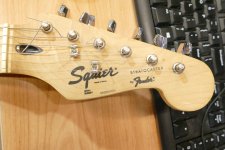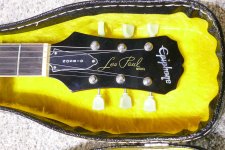Hi everyone. Its been years since I was here. I gave up playing guitar/bass for a while and now I'm back. since I've been away the likes of Squire and Epiphone have been turning out some high quality (meaning consistent, error free well finished) guitars in the far east. However some of the components are 2nd tear so a culture of retro fitting electrics has grown up. Not just pickups but pots ( I don't get why) and caps - orange drop or even paper in oil.
Can any one hear the difference? Is there a scientific reason why 50 or 70 year old technology cap would sound different ( assuming the same values)?
Can any one hear the difference? Is there a scientific reason why 50 or 70 year old technology cap would sound different ( assuming the same values)?
The tone caps that I have replaced usually were ceramic types, and those tended to be of cheaper quality and were older. I don't hear a difference with film types, which are generally what I go with..yes orange drops are fine. Paper in oil are fine too, just need to make sure they aren't electrically leaky. Maybe part the "sound" of old paper in oil caps , they have some resistance across the terminals (maybe over 1 Meg) and that may change the tone circuit response.
sure, but are they in any way better? Is it advantageous to replace a new ceramic?orange drops are fine. Paper in oil are fine too
Ceramics (except for certain types) are microphonic, and I would want to replace them solely for that. Open it up so you can touch the cap with a screwdriver, turn the tone control down (so the cap is fully in the circuit) and touch the cap with a screwdriver. If you hear any sound out of the amp, you may want to replace the cap. Further than that, and as long as it's not electrically leaky as mentioned, I don't think brand names or types make a difference.
Pots can vary in how long they go before they become scratchy (though in a solid body guitar they're pretty well sealed from dust), and I presume the larger, more expensive ones are better, but I don't have any data to back that up. About five years ago I had a Silvertone (the Danelectro two-pickup) that had a scratchy pot (it didn't cut out, but turning it up and down while the strings were playing would give a scratchy sound), a shot of the pot cleaner cleared it up. Not too bad for about a 60 year old instrument.
Pots can vary in how long they go before they become scratchy (though in a solid body guitar they're pretty well sealed from dust), and I presume the larger, more expensive ones are better, but I don't have any data to back that up. About five years ago I had a Silvertone (the Danelectro two-pickup) that had a scratchy pot (it didn't cut out, but turning it up and down while the strings were playing would give a scratchy sound), a shot of the pot cleaner cleared it up. Not too bad for about a 60 year old instrument.
A good ceramic like COG/NCO will have a low voltage coefficient of capacitance, negligible drift with temperature and probably no discernable difference audibly.sure, but are they in any way better? Is it advantageous to replace a new ceramic?
But if it`s an older ceramic cap of questionable origin, subbing in with a film cap costs little money. I`d at least measure the ceramic cap to see if it`s within reasonable tolerance. Cheers!
I would worry about microphony which Isa legitimate concern and a proven fact but not about anything else.
In fact a guitar tone control works BACKWARDS, it murders sound which the pickup maker worked so hard to get, by shorting mids and highs to ground.
Conceptually a better capacitor (lower inductance, lower ESR) will murder sound even more, go figure.
In fact a guitar tone control works BACKWARDS, it murders sound which the pickup maker worked so hard to get, by shorting mids and highs to ground.
Conceptually a better capacitor (lower inductance, lower ESR) will murder sound even more, go figure.
What exactly do you mean? Are you after Chris Squire's signature bass guitar sound? Well, he most probably didn't play an Epiphone bass guitar. His sound is associated with the Rickenbacker 4001, modified for stereo output, which later became the Rick-O-Sound feature in stock Rickenbacker bass guitars.since I've been away the likes of Squire and Epiphone...
Best regards!
"What exactly do you mean? Are you after Chris Squire's signature bass guitar sound? Well, he most probably didn't play an Epiphone bass guitar. His sound is associated with the Rickenbacker 4001, modified for stereo output, which later became the Rick-O-Sound feature in stock Rickenbacker bass guitars."since I've been away the likes of Squire and Epiphone have been turning out some high quality (meaning consistent, error free well finished) guitars in the far east.
Squier is Fender's second tier brand. They have been made in various locations by several subcontractors over the years. The quality has varied from junk (the white Indonesian Strat that I had for about a year) to reasonably decent (this Korean Strat that I bought new sometime in the 80's). It did do a spontaneous unplanned random disassembly event many years ago that left a gash in my belly. For that it was sentenced to about 10 years in a box fully disassembled. See post #3629 here:
https://www.diyaudio.com/community/threads/what-did-you-last-repair.313739/page-182#post-7290844
Epiphone is Gibson's second tier brand. They were bought by Gibson in the 90s maybe. They made some of the same guitars to the same specs as Gibson. My Les Paul wears both brand names. My wife bought me a guitar just like this one for my 50th birthday. It played fine through an amp but made a really annoying rattle when played without amplification. It rattled all the time you just didn't hear it when the amp was on. I resisted the temptation to rip it apart, so back to the music store we went. This one is its twin from the music store. It is a good, but heavy guitar. Most genuine Les Pauls are heavy due to the density of the Mahogany wood. Some cheap clones use cheap wood and are much lighter.
As for "tone caps" someone once gave me $20 for a box full of "Bumble Bee" caps that I cut out of some OLD military junk. My Fluke 407D power supply still has a few of them in it. They make everything I connect to it sound "special" 😊
Attachments
Of course. But he wrote Squire...Squier is Fender's second tier brand.
Best regards!
1957.Epiphone is Gibson's second tier brand. They were bought by Gibson in the 90s maybe.
One would think in a guitar - with zero DC to block - that would be the least of a problem. As in you could use a leaky cap in that spot, where within a tube amp, it coundnt function correctly, disrupting the bias of the stage that follows.Paper in oil are fine too, just need to make sure they aren't electrically leaky.
I bought some piece of test gear at a yard sale. In there was a bumble bee cap; just the right value. Sold it for $50 on ebay - this was years ago, probably at the heyday of players belief that these make a difference. Or someone just wanted the original detail to put the cherry on top and was willing to pay me for it.
I'd replace a ceramic in a passive guitar tone control with a PIO or polyprop "just because" I happen to have them. But what you really want to do is put a buffer in, deal with the 9V battery placement, so as to unload the pickups from anything - that would make more of a difference than a cap type change. Perhaps something like -
Cable capacitance is key to the overall guitar tone...only if you are plugging in directly. Hendrix used a coil cable for a reason! But if you use pedals, they act as buffers and negate much of the "capacitance effect". but I totally agree with Kay in that many buffers can suck the life out of an instrument...
Do you think a coiled guitar cable has an increased inductance? Then you need to remember that it forms a bifilarly wound inductor! Supposedly it's sound isn't different from any other cable with the same capacitance. Hendrix and many others used coiled instrument cables just for more freedom on stage, I think.
Best regards!
Best regards!
If you run across those old ceramic caps that are covered in what looks like a waxy/oily paper, usually in lower cost older guitars..those are the ones that are likely going to be microphonic, absorb moisture and electrically speaking not a very good audio filter cap. For a few dollars an orange drop would be a good replacement. Gibson uses the CDE Orange Drops in newer Les Pauls, they are rugged, consistent values, stable etc. The other subject would be the volume and tone potentiometers. Quality pots will make a difference! Sometimes changing the resistance value from a 250K to 500 K (acounting for the capacitor value as well) will help too.
I was speaking about capacitance, given that a coiled cable such as a 30-footer is close to 50 feet when relaxed, you get higher capacitance due to the increased cable length, which in turn rolls off the high end. If you plug a strat into a 100-watt Marshall, you can imagine that you would want some of the high-end rolled-off. Given also that he was using fuzz pedals can you imagine the tone difference when you switch one of those early fuzz faces off? Yikes... I think he got a little of both by using a coiled cable...
I wonder what the technical reason would be for your observation? Obviously there's an inductor and capacitor involved and usually that means resonance or at least a filter of some sort. Or, could the buffer have limited the dynamic range somehow? My old Gibson EBO would put out peaks in volts when loaded to 1 Meg input on the digital sampling oscilloscope...I once had a similar buffer in my `78 Fender Jazz Bass. The outcome was a flat, boring, colourless sound. I think the cable capacitance is an essential contribution to a guitar's sound, so I'd not advocate that.
- Home
- Live Sound
- Instruments and Amps
- Orange drop in passive tone: Myth or legend?

